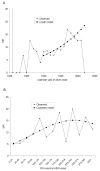Non-AIDS-defining malignancies in HIV-infected persons: etiologic puzzles, epidemiologic perils, prevention opportunities
- PMID: 19349851
- PMCID: PMC2677638
- DOI: 10.1097/QAD.0b013e328329216a
Non-AIDS-defining malignancies in HIV-infected persons: etiologic puzzles, epidemiologic perils, prevention opportunities
Abstract
Non-AIDS-defining malignancies have come to represent a growing fraction of the overall cancer burden in HIV-infected people, as improvements in HIV therapy prolong survival and reduce the incidence of AIDS-associated cancers. This review focuses on five non-AIDS-defining malignancies for which HIV-infected persons have an elevated risk, for which risk is substantial or increasing over time, and for which HIV infection may play an etiologic role. Among HIV-infected persons, lung cancer risk is high, in part due to frequent tobacco use in this population. Risks of anal cancer and liver cancer are also elevated, related to the high prevalence of infections with human papillomavirus and hepatitis B and C viruses. In addition, risk is elevated for Hodgkin lymphoma and several rare skin cancers, including Merkel cell carcinoma and sebaceous carcinoma. For anal cancer and Hodgkin lymphoma, it is particularly concerning that incidence in HIV-infected persons has risen in recent years, when highly active antiretroviral therapy has been available. Accumulating evidence supports the possibility that the high prevalence of known carcinogenic exposures (e.g., tobacco) and infections with oncogenic viruses does not completely explain the occurrence of these cancers. Indeed, HIV may act to increase the risk for each of these five non-AIDS-defining malignancies, although the mechanisms may vary, including immunosuppression, immune reconstitution, and chronic inflammation. These non-AIDS-defining cancers also present important opportunities for prevention (e.g., smoking cessation), screening (e.g., periodic anal Pap smear screening), and early detection.
Figures


References
-
- Engels EA, Pfeiffer RM, Goedert JJ, Virgo P, McNeel TS, Scoppa SM, Biggar RJ. Trends in cancer risk among people with AIDS in the United States 1980-2002. AIDS. 2006;20:1645–54. - PubMed
-
- 1993 revised classification system for HIV infection and expanded surveillance case definition for AIDS among adolescents and adults. MMWR. 1992;41:1–19. - PubMed
-
- International Agency for Research on Cancer. Human papillomaviruses. Lyon, France: 2007.
-
- Biggar RJ, Chaturvedi AK, Goedert JJ, Engels EA. AIDS-related cancer and severity of immunosuppression in persons with AIDS. J Natl Cancer Inst. 2007;99:962–72. - PubMed
Publication types
MeSH terms
Grants and funding
LinkOut - more resources
Full Text Sources
Medical
Research Materials

